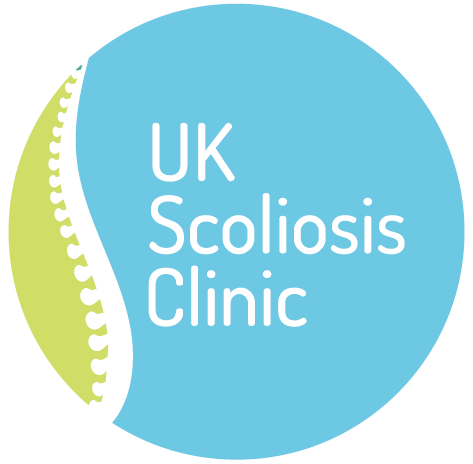Explore Treatments
Learn More
Scoliosis Bracing

Scoliosis braces are the most effective non-surgical method for reducing cobb angle.[1] There are many different kinds of scoliosis brace and many work slightly differently, however broadly speaking braces can be classified as active correction braces (which aim to reduce scoliosis by guiding the spine back to correct posture) and passive braces (which aim to prevent scoliosis from developing any further by holding the spine in its current position).
What is bracing?
Scoliosis braces are designed to either halt the progression of scoliosis or – (in the case of modern braces)
seek to gently realign the spine away from the scoliotic position.
Braces are the most effective non-surgical way to reduce cobb angle and can be even more effective in terms of overall functional improvement
(balance, posture etc.) when paired with scoliosis specific exercise. Braces are generally worn during the day and for as long as necessary at night to make up the correct wear time as prescribed by a scoliosis practitioner.
Night-time braces are also an attractive option for single curves not exceeding 35 degrees in magnitude. [2]
Our analysis
There has been a great deal of research and development in the field of scoliosis bracing during the last 10 years. Today, it is fair to say that specialised scoliosis bracing when prescribed for high-risk patients, can prevent the need for surgery in most cases. [3] Early diagnosis assists with a successful bracing outcome - conservative treatment with a brace is highly effective in treating juvenile idiopathic scoliosis, with most patients reaching a complete curve correction [4], whereas Part-time bracing in adults significantly reduces progression of curvatures and improves quality of life. [5]
Learn more
-
How does bracing work?
Modern scoiosis braces are worn during the day and sometimes at night, during which time they gently guide the spine back into the correct position. Unlike many older styles of brace, newer models such as ScoliBrace are low profile, permit normal movement and participation in sporting activities and can easily be put on and taken off by the wearer.
-
How effective is bracing?
Considered as a whole, bracing is an effective treatment method for scoliosis cases, characterized by positive long-term outcomes. [6] Results vary by brace – but some studies have shown success rates with bracing as high as 100%. [7]
Amongst non-surgical scoliosis treatments bracing is the most effective method for reducing a cobb angle and is often paired with scoliosis specific exercise or other complementary therapies aimed at reducing the muscle imbalances associated with scoliosis, as bracing alone will not address this issue directly. -
When to choose bracing
Scoliosis bracing in children and adolescents is recommended when Cobb angles over 25° are observed and there is a risk of progression as the child grows. For cobb angles under 25°, bracing might still be a preferred treatment option, since (unlike exercise) no conscious effort is necessary from the user.
Many scoliosis specialist clinics combine bracing with other methodologies, such as scoliosis specific exercises as part of their treatment plan.
Today there are also specialist braces for patients with smaller curves which can be worn at night. -
Research and References
Sources for further research
TB Grivas, ES Vasiliadis, C Maziotou, OD Savvidou, The direct cost of Thriasio school screening program. Scoliosis 2(1) (2007) 7.
TB Grivas, MH Wade, S Negrini, JP O’Brien, T Maruyama, M Rigo, HR Weiss, T Kotwicki, ES Vasiliadis, LS Neuhaus, T Neuhous, School Screening for Scoliosis. Where are we today? Proposal for a consensus. Scoliosis 2(1) (2007) 17
WP Bunnel, Selective screening for scoliosis. Clin Orthop Relat Res 434 (2005) 40-5
T.B. Grivas et al. “How to Improve the Effectiveness of School Screening for IS” The Conservative Scoliosis Treatment (2008) p 120
References for this page
[1] Yu Zheng, MD PhD et al. Whether orthotic management and exercise are equally effective to the patients with adolescent idiopathic scoliosis in Mainland China? – A randomized controlled trial study SPINE: An International Journal for the study of the spine (2018) [Publish Ahead of Print]
[2] Grivas TB, Rodopoulos GI and Bardakos NV, ‘Biomechanical and clinical perspectives on nighttime bracing for adolescent idiopathic scoliosis‘ Stud Health Technol Inform. 2008;135:274-90.
[3] Stuart L. Weinstein, Lori A. Dolan, James G. Wright, and Matthew B. Dobbs. ‘Effects of Bracing in Adolescents with Idiopathic Scoliosis’ [Results of the BrAIST Clinical Trial] N Engl J Med 2013; 369:1512-1521
[4] Angelo G Aulisa, Vincenzo Guzzanti, Emanuele Marzetti,Marco Giordano, Francesco Falciglia and Lorenzo Aulisa. ‘Brace treatment in juvenile idiopathic scoliosis: a prospective study in accordance with the SRS criteria for bracing studies – SOSORT award 2013 winner' Scoliosis 2014 9:3
[5] Palazzo C, Montigny JP, Barbot F, Bussel B, Vaugier I, Fort D, Courtois I, Marty-Poumarat C. 'Effects of Bracing in Adult With Scoliosis: A Retrospective Study' Arch Phys Med Rehabil. 2016 Jun 22 . pii: S0003-9993(16)30256-8
[6] Aulisa et al, Curve progression after long-term brace treatment in adolescent idiopathic scoliosis: comparative results between over and under 30 Cobb degrees Scoliosis and Spinal Disorders 2017 12:36
[7] De Giorgi S, Piazzolla A, Tafuri S, Borracci C, Martucci A, De Giorgi G. Chêneau brace for adolescent idiopathic scoliosis: long-term results. Can it prevent surgery? Eur Spine J.2013;22(6):S815–22, and Aulisa AG, Guzzanti V, Perisano C, Marzetti E, Falciglia F, Aulisa L.Treatment of lumbar curves in scoliotic adolescent females with progressive action short brace: a case series based on the Scoliosis Research Society Committee Criteria. Spine (Phila Pa 1976). 2012;37(13):E786-E791.
Need advice?
Learn more about scoliosis and book a free consultation at the UK Scoliosis Clinic .
Learn More